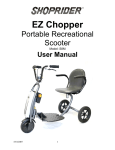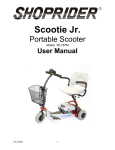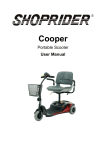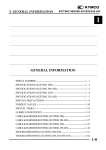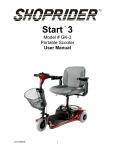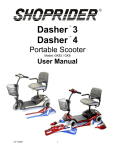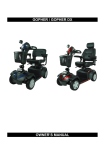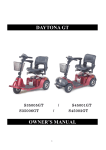Download Drive STINGRAY Owner`s manual
Transcript
OWNERS MANUAL & INSTRUCTIONS 12 Harbor Park Drive, Port Washington, NY 11050 Toll Free: 877-224-0946 • 516-998-4600 Website: www.drivemedical.com TABLE OF CONTENTS PREFACE & INTRODUCTION 3 SAFETY NOTICE Before Driving While Driving Labeling EMI 4 PARTS INTRODUCTION Parts Description 10 OPERATION Control Panel How to Operate Your Scooter How To Set To Freewheel Mode 11 DRIVING ON THE ROAD 15 BATTERY CHARGING AND CARE Charging The Battery Charger Battery 17 INSPECTION AND MAINTENANCE Daily Checking Regular Checking Record Battery, Fuse and Tire Maintenance Storage Moving About Disassembling The Scooter For Transportation Assembling The Scooter 21 TROUBLE SHOOTING 27 SPECIFICTION 28 WARRANTY 29 PREFACE AND INTRODUCTION Please carefully read this owner’s manual before using the vehicle. Improper use of the vehicle could result in harm, injury or traffic accidents. To ensure that you get the most from your scooter, please read this owner’s manual before using. • This owner’s manual includes operation instructions for every aspect of the vehicle, assembly instructions, as well as instructions for how to deal with possible accidents. • The symbols used in this manual are explained overleaf: WARNING Improper usage could result in serious injury or death. ATTENTION Improper usage could lead to injury and/or damage to your scooter. SUGGESTION Follow these instructions to keep your vehicle in a good operating order. • This manual includes a repair and maintenance record chart and warranty information. Please keep it in a safe place or in the scooter. • If someone else uses the scooter make sure that you provide him or her with this owners handbook for his or her consideration. • As designs change some illustrations and pictures in the manual may not correspond to the vehicle that you purchased. We reserve the right to make design modifications. The Stingray series of scooters have been designed and manufactured to provide a comfortable and secure yet affordable solution for some mobility requirements. 3 SAFETY NOTICE Before Driving The user needs to be familiar with the usage and operation of this vehicle before driving. Therefore, please follow the recommendations in this safety notice. THE SAME TRAFFIC RULES APPLY TO THE USE OF THIS VEHICLE AS APPLY TO PEDESTRIANS • For your safety, please follow the rules that apply to pedestrians. • Ride on the pavement and pedestrian areas only, never ride on motorways or dual carriageways. Only use to cross to the other side of the pavement. • Be aware of traffic when crossing roads. • Be extremely cautious when driving your scooter on busy streets or in shopping malls. • Please do not drive your scooter after consuming alcohol or when you are tired. • Please be careful when driving your scooter in low light. It has not been designed for use at night. PRACTICE OPERATING YOUR VEHICLE Before using the scooter in busy or potentially dangerous areas, familiarize yourself with the operation of your scooter. Please practice in a wide and open area like a park. In order to avoid accidents with your scooter while driving, please bare in mind driving motions, such as accelerating, stopping, turning, reversing, up-and down ramps. • Please turn the speed dial to minimum value for your initial practice. • Only use higher speed setting when you are confident that you can easily operate and control your scooter. THE SCOOTER IS ONLY TO BE USED BY ONE PERSON AT A TIME • Do not carry passengers on your scooter (including children) DO NOT USE THIS VEHICLE TO CARRY OR HAUL GOODS • The maximum weight can be carried is 250 lbs. (including occupant and any goods). Refer to “MAX LOAD WEIGHT” in “SPECIFICATION” • Maximum loading weight for basket is 7lbs (3kg). 4 SAFETY NOTICE WHILE DRIVING • • • • • Please carry out daily inspections. Refer to the section entitled “DAILY CHECKING” Do not move your body out of the vehicle while moving Such action may cause you to loose balance and risk injury from falling. Pay attention that your clothes do not tangle in the wheels. DO NOT USE YOUR VEHICLE UNDER THE CIRCUMSTANCES BELOW. • On roads with heavy traffic or roads that are muddy, gravely, bumpy, narrow, snowed over, icy, or paths not guarded by any fence or hedge. Keep away from places where you might get the wheels stuck. • Do not drive at night or when it is raining, snowing, misty, or windy. • Do not drive your vehicle in an “S” pattern or make erratic turnings. • Do not take the scooter onto escalators. • UNDER NO CIRCUMSTANCES SHOULD THE SCOOTER BE USED AS A SEAT IN A MOTOR VEHICLE (E.G. CARS, BUSES, TRAINS, ETC). ABOUT MOBILE PHONES AND OTHER ELECTRICAL EQUIPMENT • Do not use a mobile phone or other wireless communication devices while driving. • Always switch off the scooter and remove the ignition key before using a mobile phone. • Do not charge the mobile phone or any other electrical devices from your scooter’s battery. AUTOMATIC POWER SHUT DOWN • In order to avoid accidental battery run down, your scooter is equipped with an automatic power shut down facility. If the scooter is switched on, but remains undisturbed for a period of thirty minutes it will automatically turn off. Should this occur, simply switch your scooter off and back on and it will be ready to use once again. RAMPS, INCLINES AND DROPS • Do not drive onto steep ramps greater than the specified gradient. Refer to the section entitled “CLIMBING ANGLE” in “SPECIFICATION” • Always use a low speed setting when ascending or descending a gradient. • Do not drive on roads with large drops or potholes. Refer to the section entitled “MAX. GROUND CLEARANCE” in “SPECIFICATION”. • Do not cross water gutters where the width is too big and where there is a risk of getting the wheels stuck. • Please slow down when driving on gradients. • Do not make sudden turns when driving on gravel roads or ramps. • Always lean forward when climbing a steep gradient. 5 SAFETY NOTICE WARNING! • Do not set in the freewheel mode when driving on a gradient. • Always re-engage the anti-freewheel device before use. Failure to do so may result in injury. • To protect your safety, the power will automatically cut off and electromagnetic brake system will activate while you are driving down a steep gradient (over 8º). This will limit the speed to a safe level. Turn the power on again to re-start your scooter. • Maximum User Weight Limit Refer to section entitled “MAX. LOAD WEIGHT” in “SPECIFICATION”. Overloading past the weight limit may lead to damage of your scooter or cause it to malfunction and will endanger your safety. The warranty does not cover this type of damage. 6 SAFETY NOTICE FIGURE 1. MAXIMUM RECOMMENDED INCLINE ANGLES LABELING WARNING Please carefully read all labels on the scooter before driving it. For your future reference, do not remove them. • Please hold the tiller before loosening the tiller adjustment knob. • Before lifting or driving the scooter make certain the tiller adjustment knob is fully tightened. • Never attempt to adjust the tiller while the scooter is motion. WARNING WARNING • Never operate the freewheel lever while LEVER seated on the scooter or on an incline! OPERATION OF THE FREEWHEEL LEVERmode • Always pull UP FIRMLY for freewheel mode • Always push DOWN FIRMLY for drive mode READ OWNER’S MANUAL AND CHARGE BATTERY BEFORE OPERATING Do not exceed recommended Inclines and weight limits. WARNING DISCONNECT BEFORE SEPERATING FRAME REFER TO OPERATORS MANUAL FOR INFORMATION WARNING Radio waves may affect scooter control. Radio wave sources, such as radio stations, amateur radio (HAM) transmitters, two-way radios, and cellular phones, can affect powered motorized scooters. Following the warning listed below should reduce the chance of unintended brake release or powered scooter movement which could result in serious injury. 1. Do not turn ON hand-held personal communication devices, such as citizens band (CB) radios and cellular phones, while the powered scooter is turned ON. 2. Be aware of nearby transmitters, such as radio or TV stations, and try to avoid coming close to them. 3. If unintended movement or brake release occurs, turn the powered scooter OFF as soon as it is safe. 4. Be aware that adding accessories or components, or modifying the powered scooter, may make it more susceptible to interference from radio wave sources. (Note: There is no easy way to evaluate their effect on powered scooter.) 5. Report all incidents of unintended movement or brake release to the powered scooter manufacturer, and note whether there is a radio wave source nearby. 7 SAFETY NOTICE EMI This portion of the content will provide the user with basic information that describes the problems with EMI, known sources of EMI, protective measures either to lessen the possibility or exposure or to minimize the degree of exposure, and suggested action should unexpected or erratic movement occur. CAUTION: It is very important that you read this information regarding the possible effects of electromagnetic interference on your electric SCOOTER. ELECTROMAGNETIC INTERFERENCE (EMI) FROM RADIO WAVE SOURCES Powered vehicle may be susceptible to electromagnetic interference (EMI), which is interfering electromagnetic energy (EM) emitted from sources such as radio stations, TV stations, amateur radio (HAM) transmitters, two-way radios, and mobile phones. The interference (from radio wave sources) can cause the powered scooter to release its brakes, move by itself, or move in unintended directions. It can also permanently damage the powered scooter’s control system. The intensity of the interfering EM energy can be measured in volts per meter (V/m). Each powered scooter can resist EMI up to a certain intensity. This is called its “immunity level”. The higher the immunity level, the greater the protection. At this time, current technology is capable of achieving at least a 20 V/m immunity level, which would provide useful protection from the more common sources of radiated EMI. This powered scooter model as shipped, with no further modification, has an immunity level of 20 V/m without any accessories. There are a number of sources of relatively intense electromagnetic fields in the everyday environment. Some of these sources are obvious and easy to avoid. Others are not apparent and exposure is unavoidable. However, we believe that by following the warning listed below, your risk to EMI will be minimized. The sources of radiated EMI can be broadly classified into three types: 1. Hand-held portable transceivers ( transmitter -receivers with the antenna mounted directly on the transmitting unit. Examples include: citizens band (CB) radios, “ walkie talkie”, security, fire, and police transceivers, cellular telephones and other personal communication devices. NOTE: Some mobile telephones and similar transmit signal while they are ON, even when not being used. 2. Medium-range mobile transceivers, such as those used in police cars, fire trucks, ambulances and taxis. These usually have the antenna mounted on the outside of the scooter. 8 SAFETY NOTICE 3. Long-range transmitters and transceivers, such as commercial broadcast transmitter (radio and TV broadcast antenna towers) and amateur (HAM) radios. NOTE: Other types of hand-held devices, such as cordless phones, laptop computers, AM/FM radios, TV sets, CD player, and cassette players, and small appliances, such as electric shavers and hair dryers, so far as we know, are not likely to cause EMI problems to your powered scooter. POWERED VEHICLE ELECTROMAGNETIC INTERFERENCE (EMI) Because EM energy rapidly becomes more intense as one moves closer to the transmitting antenna (source), the EM fields from hand-held radio wave sources ( transceivers ) are of special concern. It is possible to unintentionally bring high levels of EM energy very close to the control system of powerchair while using these devices. This can affect powered vehicle movement and braking. Therefore, the warnings listed below are recommended to prevent possible interference with the control system of the powered scooter. WARNINGS Electromagnetic interference (EMI) from sources such as radio and TV stations, amateur radio (HAM) transmitters, two-way radios, and mobile phones can affect powered scooter and motorized scooter. Following the warnings listed below should reduce the chance of unintended brake release or powered scooter movement, which could result in serious injury. 1. Do not operate hand-held transceivers-receivers), such as citizens band (CB) radios, or turn ON personal communication devices, such as cellular phones, while the powered vehicle is turned ON; 2. Be aware of nearby transmitters, such as radio or TV stations, and try to avoid coming close to them; 3. If unintended movement or brake release occurs, turn the powered vehicle OFF as soon as it is safe; 4. Be aware that adding accessories or components, or modifying the powered vehicle, may make it more susceptible to EMI ( Note: There is no easy way to evaluated their effect on the overall immunity of the powered vehicle), 5. Report all incidents of unintended movement or brake release to the powered vehicle manufacturer, and note whether there is a source of EMI nearby, IMPORTANT INFORMATION 1. 20 Volts per meter (V/m) is a generally achievable and useful immunity level against EMI (the higher the level, the greater the protection), 2. This product has an immunity level of 20 V/m without any accessories and connected to it. 9 PARTS INTRODUCTION PARTS DESCRIPTION 1. Speed Dial 2. Charger Socket Cover 3. Basket 4. Tiller 5. Tiller Adjustment Bolt 6. Arm Rest 7. Seat Post 8. Rear Reflector 1 9. Freewheel Mode Lever 10. Anti-tip wheels 6 3 7 4 2 5 9 8 10 10 OPERATION CONTROL PANEL 4 1. Speed Dial 2. Horn Button 3. Speed Control Lever 4. Battery Indicator 5. Power Switch 6. Power Eye 6 1 3 2 5 HOW TO OPERATE YOUR SCOOTER Power switch • To switch the power on, turn the key clockwise in the ignition. The power eye should illuminate. • To switch the power off, turn the key counter clockwise. The power eye should switch off and the key can be removed if required. Speed Dial Turn the speed dial to determine the maximum speed of the scooter. Turn the dial clockwise to increase the speed setting and turn the dial counter clockwise to decrease the speed setting. Slowest setting fastest setting. Slowest Setting Fastest Setting Moving and Braking • Push the right-hand side speed control lever forwards with your right thumb and the scooter will move forward. • Push the left-hand side speed control lever forwards with your left thumb and the scooter will move backward. • To brake, release the speed control lever which will return to neutral and activate the electromagnetic brake automatically .This will bring the scooter to a prompt stop. • The speed control lever allows you to control the speed of the scooter up to a maximum speed determined by the Speed Dial .The further the speed control lever is deflected, the faster the scooter will go. 11 OPERATION Horn Button Press the horn button to sound the horn. Release the button Braking Electro-magnetic brake: Release the speed control lever will be activated automatically, and the scooter will stop. WARNING When on a gradient NEVER set the vehicle to the freewheel be applied. This may result in injury or damage. Seat • The seat can be rotated and locked in position at 45º. • Push the seat adjustment lever forward and swivel seat. • Release the lever, and then continue swiveling the seat it locks in position. ATTENTION Return the seat to the forward position before driving. 12 OPERATION BATTERY INDICATOR • The battery indicator on the tiller console uses a color code to indicate the approximate power remaining in your batteries. Green indicates (40°-100%) capacity, yellow a draining charge (10°-30%),and red indicates that an immediate recharge is necessary. • The remaining power suggested by the battery indicator will vary by the actual driving time incurred and how you drive. Repeated starting, stopping, climbing will consume the power more quickly. SUGGESTION 1. You should recharge the batteries after each time the vehicle is used to ensure maximum range. The batteries should be charged up at least once a week even if the scooter is not used. 2. After charging or replacing a new battery, drive the vehicle for 2-3 minutes to make sure the battery capacity is sufficient. 3. In wintertime, the battery may respond more slowly and the battery range may be reduced. 4. When driving on a gradient, the battery indicator gauge may fluctuate. This is a normal phenomenon. 5. Even if the battery is used properly, it is natural for the battery’s capacity to reduce with time, which results in reduced battery range compared to a brand new battery. Therefore, when you find the battery’s range is about only 50% of the range when the batteries were new, it is time to replace the batteries. Please see your dealer about replacement batteries. If you continue to use the old battery when it should be replaced, it could lead to a rapid decline in performance. 6. The battery range will be reduced when driving frequently on a slope or rough terrain, as this leads to greater consumption of power. 7. The batteries have a twelve-month warranty covering manufacturing defects. This warranty does not cover faults due to incorrect battery recharging. 13 OPERATION HOW TO SET TO FREEWHEEL MODE • Engaged Mode (Fig. 4.1): Push the lever down completely, the scooter can be driven by motor power. • Freewheel Mode (Fig 4.2): Lift the lever up completely, the scooter can be moved manually. Fig 4.1 Engaged Mode Fig 4.2 Freewheel Mode WARNING Never operate the freewheel level while seated on the scooter or on an incline. TILLER ADJUSTMENT • The tiller can be adjusted in to many different positions to suit each driver. The tiller can be adjusted by following the steps below. 1. 2. Loosen the knob to adjust the tiller to positions you want. (Fig.4.3) Once decide the position, tighten the knob to secure the tiller. (Fig.4.4) Fig 4.3 Fig 4.4 14 OPERATING YOUR STINGRAY STARTING AND DRIVING 1. Make sure the seat is installed properly. 2. Make sure the tiller has been secured properly. 3. Fold down the armrests so you can rest your arms on them. 4. Turn the power switch to “ON”. 5. Check battery indicator to see whether there is enough power for your journey. If you have any doubt about the remaining power, please recharge the batteries before departure. 6. Set the speed dial to a position you feel safe and comfortable with. 7. Check the forward/reverse speed lever works correctly. 8. Make sure the electromagnetic brake works correctly. 9. Before driving, ensure it is safe to do so in the environment around you. ATTENTION 1. Do not push both RH & LH sides of the speed control lever simultaneously. This might leave you unable to control your scooter. 2. Do not turn the power switch to OFF while driving as this will lead to an emergency stop and possible risk of accident and injury. 3. Do not set to the highest speeds while driving indoors. 4. Do not adjust the speed dial while driving, a sudden change in speed may cause danger to you and others, and may cause damage to your scooter. 5. Do not place magnetic devices near the area of the operation handle as this could affect the safe operation of your scooter. 6. Do be careful while driving in heavy traffic or crowded areas. 7. While reversing the vehicle, beware of people or objects behind you. STOPPING 1. Release the speed control lever completely. The vehicle will naturally brake and stop. 2. Turn the scooter off at the key. Then pull out the key. ATTENTION • The stopping distance will vary with your forward / reverse speed. Therefore please begin braking as early as you can. • While parking your scooter, be sure to park on flat ground and then turn the power to “OFF” before you get off. 15 OPERATING YOUR STINGRAY MAIN CIRCUIT BREAKER ( RESET BUTTON ) When the voltage in your scooter’s batteries becomes low or the scooter is heavily strained because of excessive loads or steep inclines, the main circuit breaker may trip to protect the motor and electronics from damage. The location of the circuit breaker is shown by the arrow on the photograph (left). If the circuit breaker is activated simply push the black button back in to reset the circuit breaker. Please note the normal position of the circuit breaker button as a point of reference .The button protrudes by 2-3 mm when operating normally, and protrudes by 7-8 mm when the circuit breaker has activated. 16 BATTERY CHARGING AND CARE CHARGING THE BATTERY Follow the procedure below step by step: 1. Turn the power switch to (OFF). 2. Connect the charger’s power cord into the power outlet. 3. Open the charging rubber cover on the rear shroud. Then connect the charger’s round plug to the charging socket. 4. Switch the charger on. 5. Both the charger’s red and orange LEDs will be lit when charging. The charging duration is about 10 hours. To ensure optimum performance a 12-14 hour charge is recommended. 6. Both the charger’s LEDs will be lit during the charging process. The orange LED will turn green when charging is complete. 7. Turn off the charger, disconnect the power cord and the round plug from charger socket on the scooter. 17 BATTERY CHARGING AND CARE SUGGESTION 1. Do not disconnect the charger cord if charging is not completed. The battery life will be seriously shortened or decayed if the battery is repeatedly used without being fully charged. Therefore be sure to charge the battery fully every time. 2. Always complete the charging until the orange LED light turns green. NEVER stop charging before it is complete. 3. When fully charged, the battery charger will still trickle charge the battery to ensure optimum range. 4. If you do not use your scooter for a long time, it should be charged at least every week to keep the battery in a fully usable condition. 5. The ambient temperature will affect charging time. Charging time will be longer in the winter. 6. After charging, do not leave the charger socket plugged in to the scooter, as this will cause a power drain on the scooter and temporarily reduce its range. 7. The batteries carry a twelve-month manufacturer's warranty. This warranty only covers issues relating to manufacturing faults, and not faults relating to failure to recharge the batteries as instructed above. 8. Should range or power problems arise, please charge your scooter for 24 hours continually and then retry the scooter. ATTENTION: Please follow the rules below to avoid accidents while charging. 1. Please use the 24V charger that comes with your scooter only, and recharge the battery to its full capacity every time. You may damage the battery and scooter if you use a charger which is not to the correct specification. 2. Never disassemble or modify the charger. 3. Please charge in a well-ventilated space where it is not directly exposed to the sunlight. Do not charge in surroundings where it is humid or under rainfall and morning dews. 4. Do not charge in temperatures less than 14°F or higher than 122°F as the charger may not work well and the batteries may become damaged. WARNING 1. Keep away from flammable objects while charging as it may lead to fire or explosion of battery. 2. Do not smoke while charging as the battery may release hydrogen gas. Always charge your battery in a well-ventilated space. 3. Never connect or disconnect the plug or cord with wet hands while charging. Do not connect or disconnect the plug or cord when they are wet, it may lead to electric shock. 18 BATTERY CHARGING AND CARE CHARGER Both the chargers red and orange LEDs will be switched ON during charging. The orange LED will turn green when charging completed. It is recommended to leave the charger plugged in for at least 1-2 hours after the green light has become illuminated. This process may increase or maintain the performance of the batteries. WARNING • The fan inside the charger will be activated accordingly when you turn on the charger. If the fan does not work when connected to the charger or the green light is not showing, DO NOT use this charger. It may lead to overheating of the charger and cause a fire. • There is a red LED present on the charger to illustrate operation. If this LED does not illuminate the charger is faulty, please contact your dealer. BATTERY • Do not expose the battery to temperatures below 50°F or above 122°F when charging or storing the vehicle. Being out of the above temperature range can cause the battery either to freeze or over heat. This will damage the batteries and shorten their life. • These batteries are maintenance free and there is no need to inspect the battery liquid or refill with water. • You are required to recharge the batteries on a regular basis. Even if the scooter is stood idle, you should charge the batteries at least once a week. WARNING Do not open the battery sealed cap at any time. BATTERIES • Your scooter is powered by two deep cycle sealed lead-acid batteries. • The batteries supplied with the scooter are 12V12AH batteries. CHARGING THE BATTERY Using the charger supplied with the scooter, the charging duration is about 8 hours. However to ensure optimum performance we recommended a 12-hour charge. We also recommend that the batteries are not charged for more than 24 hours. 19 BATTERY CHARGING AND CARE CLEANING THE BATTERY If water, battery acid, dust or other substances contaminate the batteries, they will discharge quickly. The batteries supplied with the scooter are sealed and as such are maintenance free. Please follow the steps below to clean the battery. 1. Turn the scooter power switch to OFF. 2. Remove the seat and dust cover. 3. Remove the shroud. 4. Use a clean cloth to wipe off the soiled area. 5. Take out the battery. 6. Clean the battery with a clean cloth. If the terminal is covered by white powder, please wipe it clean using warm water. SUGGESTIONS If necessary, ask for help from your dealer for advice about maintaining and replacing the battery. 1. Make sure the terminals are installed properly and put the cover back on. 2. Do not use the battery to charge telecom equipment or other items. 3. Battery efficiency will vary with outside conditions, the driving distances will be shorter in the winter. If the vehicle is not used for a long time, please charge the battery at least every week. 4. Replace both batteries together. 20 INSPECTION AND MAINTENANCE DAILY CHECKING Check following items before driving. If your find anything abnormal, contact an authorized dealer for further inspection or advice before using the battery. ITEM INSPECTION CONTENT HANDLEBAR • Is there any looseness? • Can it turn left and right smoothly? SPEED CONTROL DIAL • Can it be adjusted freely and does it function well? SPEED CONTROL LEVER • Does the scooter move when the lever pressed down? • Does the scooter stop when the lever is released completely? MOTOR • Is there an abnormal noise coming from the motor? • Do the electromagnetic brakes work properly? FREEWHEEL MODE • Does the freewheel mode lever work properly? BATTERY INDICATOR • Is the light on when the power is switched on? • Is the remaining power enough for your trip? HORN • Does the horn work? SEAT • Can the seat swivel smoothly? REFLECTOR • Is the reflector present and correct? TIRES • Are there any cracks or other damage to the tires? • Check the tire tread depth. OTHER • Are there any abnormal noises? • Is there oil leakage from transmission box? ATTENTION Go to your dealer for inspection and maintenance if you find anything wrong. 21 INSPECTION AND MAINTENANCE REGULAR CHECKING RECORD To make sure your scooter is correctly serviced. Take it to your dealer for regular maintenance checks. This should be at intervals of six months after the first inspection after one month. Your dealer may charge a fee for this. SUGGESTION Even if you don’t use the vehicle for a long time it should still be regularly maintained. YEAR 1 2 3 4 YEAR Service Dates Controller On/off switch Control Lever Braking Recharge point Batteries Service Dates Upholstery Seat Back Armrests Electrics Connections condition Lights Test run Forwards Reverse Emergency stop Left turn Right turn Slope test Over obstacles List Items repaired Levels Connections Discharge test Wheels and Tires Wear Pressure Bearings Wheel nuts Motors Wiring Noise Connections Brake Brushes Chassis Condition Steering 22 1 2 3 4 INSPECTION AND MAINTENANCE BATTERY, FUSE AND TIRE BATTERY Refer to the section entitled “BATTERY” in “BATTERY CHARGING AND CARE ”. FUSE If the battery charger is turned on and no LEDs are lit, check the battery charger fuse. SUGGESTION Ask for help from your dealer to inspect or replace the fuse, since the tiller shroud has to be removed first before you can replace the fuse. TIRES The condition of the tires depends on how you drive and use your scooter. • Please check the tread depth regularly. • Replace the tires when the tread depth is less than 0.5mm. ATTENTION 1.When tread depth is below 0.5 cm it can easily lead to vehicle slippage, making braking distances longer. Therefore replace the tires as early as possible when they are found to have insufficient tread depth. MAINTENANCE • You must maintain the scooter frequently if you tend to drive on grass, sand, or gravel or in other adverse environments. Do not use water, oil or other chemical solutions to clean your scooter. Be sure NOT 23 INSPECTION AND MAINTENANCE • Do not spray the scooter with a hose or tap as this may cause damage to electronic components and the scooter controller. • Please take the scooter to authorized Dealers for repairs and adjustments. Improper adjustments could lead to accidents and scooter malfunction. • Please use a soft, dry cloth to keep your scooter clean and dust-free. Please use natural or mild detergent to clean the scooter. ATTENTION When conducting maintenance of your vehicle, please turn the power switch to OFF and remove the charger cords. SUGGESTIONS • Do not splash water directly to wash your scooter as this could lead to malfunction of the system electrics. • Do not use gasoline, solvents or vaporizing solution as these may deform or damage the shrouds. • Do not use wax. STORAGE Make sure the scooter is stored under the following condition: • Ensure the seat is set in the “forward” position. • Ensure the scooter is switched off. • Ensure the charger is disconnected when not in use. SUGGESTION Please store the scooter in a location where it is out of direct sunlight, rain, or dew. When storing for a long time, please charge the battery to full power and then disconnect the battery terminal. For details ask your dealer. TRANSPORTING • Switch off the power with the key before moving. Always dismount from the scooter before moving. • Lift the scooter by the chassis, and not by the bumpers. Lifting the scooters by the bumper could cause damage or injury. • For your safety, ask for help if required. You will need two people when moving or lifting the scooter whole. 24 INSPECTION AND MAINTENANCE DISASSEMBLING THE SCOOTER The Stingray can be disassembled to 4 pieces. The seat, front section, rear section and battery. Follow these steps to disassemble. 1. Switch the scooter off, unscrew the seat knob and remove pin. Pull up on seat to remove. 2. Open battery door, pull out battery by strap. Disconnect the batteries by disconnecting both connectors. 3. Loosen tiller adjustment knob and lower tiller. Retighten bolt when lowered. 4. Step on rear section frame until the lower pegs are no longer in the curved, locking brackets. Remove cable from battery. 1 2 3 4 25 INSPECTION AND MAINTENANCE ASSEMBLING THE SCOOTER 1. Position the front and rear sections of the scooter. Align the lower curved locking brackets of the front section with the corresponding pegs on the front of the rear section. Holding the seat first, slowly pivot the rear section forward until the curved locking brackets are fully connected onto the top rear pegs 2. Loosen the tiller adjustment bolt, raise the tiller to the desired position and tighten the bolt. 3. Reinstall the batteries and secure them with the hook and loop strap connect batteries with cables. 4. Replace the seat and rotate to align lock pin. Secure lock pin in place. WARNING After assembling your scooter, make absolutely certain the tiller adjustment knob is fully tightened. 1 2 4 3 26 TROUBLESHOOTING • When you have trouble with your scooter • You can inspect the following before taking your scooter to the dealer. PROBLEM SYMPTOM REMEDY SCOOTER WILL NOT SWITCH ON • Batteries not connected • Rear and sections not connected • Check batteries are connected • Check connection on front-to-rear loom • Circuit breaker has tipped • Push circuit breaker button to restart • Flat batteries • Check Battery Power • Charger plugged in • Unplug charger • Motor in freewheel mode • Re-engage the freewheel lever SCOOTER WILL SWITCH ON BUT WILL NOT RUN • If you cannot solve the problem by yourself, contact your dealer for help. 27 SPECIFICATION MODEL REFERENCE DIMENSION (L X W X H) WEIGHT(KG),W/I BATTERY W/O BATTERY PROPULSION MOTOR BATTERY CHARGER FRONT TIRE REAR TIRE DRIVING SYSTEM BRAKE SYSTEM CONTROL METHOD TOP SPEED (FORWARD) REVERSE CLIMBING ANGLE CRUISING RANGE (SEE NOTE) MIN. TURNING RADIUS GROUND CLEARANCE MAX. LOAD WEIGHT (INCLUDING GOODS) STINGRAY 38" X 24" X 37 " 84 LBS 63 LBS 270W X 1 12V12AH X 2 DC24V 2A 2.5-4 X 1 2.5-4 X 2 Direct drive the rear wheels (with differential gear) Electromagnetic brakes By speed control lever 4 MPH 3 MPH 8º 20 MILES 32” 2.2 ” 250 LBS. REMARK: Drive reserves the right to modify the specification if necessary. The final specification is subject to the individual scooter you purchase from your dealer. NOTE: Maximum driving distance is based on an ambient temperature of 68°F, a 165 lb. driver and a brand new fully charged battery by a constant driving speed at 4mph with 70% battery power discharged. 28 LIMITED WARRANTY Life Time Warranty: Scooter frame We will repair the frame with new or refurbished parts, free of charge, In the USA in the event of defective materials or workmanship. One Year Limited Warranty: • Electronic controller • Drive train components Drive will repair these products with new or refurbished parts, free of charge, in the U.S.A. for one (1) year from the original date of purchase in the event of defective materials or workmanship. Drive will repair these products with new or refurbished parts, free of charge, In the U.S.A. for six (6) months from the original date of purchase in the event of defective materials or workmanship. 29 LIMITED WARRANTY Warranty Exclusions • ABS plastic shrouds • Batteries (batteries are warranted by the battery manufacturer) • Tires and Tubes This warranty is extended only to the original purchaser. Your original receipt will be necessary as proof of purchase before any warranty performance is rendered. This warranty only covers failures due to defects in materials or workmanship which occur during normal use and does not cover damage that occurs in shipment or failures which are caused by products not supplied by Drive or failures resulting from accident, misuse, abuse, neglect, mishandling, misapplication, alteration, modification, commercial use or by anyone other than an authorized Dealer, or damage that is attributable to acts of God. The manufacturer reserves the right to alter without notices any weights, measurements or other technical data shown in this manual. All figures, measurements and capacities shown in this manual are approximate and do not constitute specifications. DRIVE AUTHORIZED SERVICE AGENT NAME ADDRESS TEL FAX EMAIL 30 Warranty Registration Please type or print Serial#__________________________________________Date Purchased___/___/___ Owner Name ___________________________________________________________ Address _______________________________________________________________ City ______________________________________State ________ Zip ____________ Additional Required Owner Information Please indicate your understanding of your Scooter by completing the following information. _________ I have read and fully understand __________ Owners Manual, especially sections on operating instructions, safety guidelines, maintenance and battery instructions. __________ Scooter Warranty Battery Instructions-only sealed lead acid or gel cell type batteries should be used. Batteries must also be sealed, deep cycle, and maintenance free or battery will hinder vehicle performance and void the warranty. _________ My dealer has instructed me on how to operate my Scooter. Signature ____________________________ Dealer Name _____________________ Telephone (___)_______________________ Dealer Phone (___)_________________ E-mail address _________________________________________________________ Comments ____________________________________________________________ _____________________________________________________________________ _____________________________________________________________________ _____________________________________________________________________ 31 FOLD HERE FIRST Place Stamp Here 12 Harbor Park Drive Port Washington, NY 11050 FOLD HERE SECOND SEAL WITH TAPE DO NOT STAPLE 12 Harbor Park Drive, Port Washington, NY 11050 Toll Free: 877-224-0946 • 516-998-4600 Website: www.drivemedical.com


































